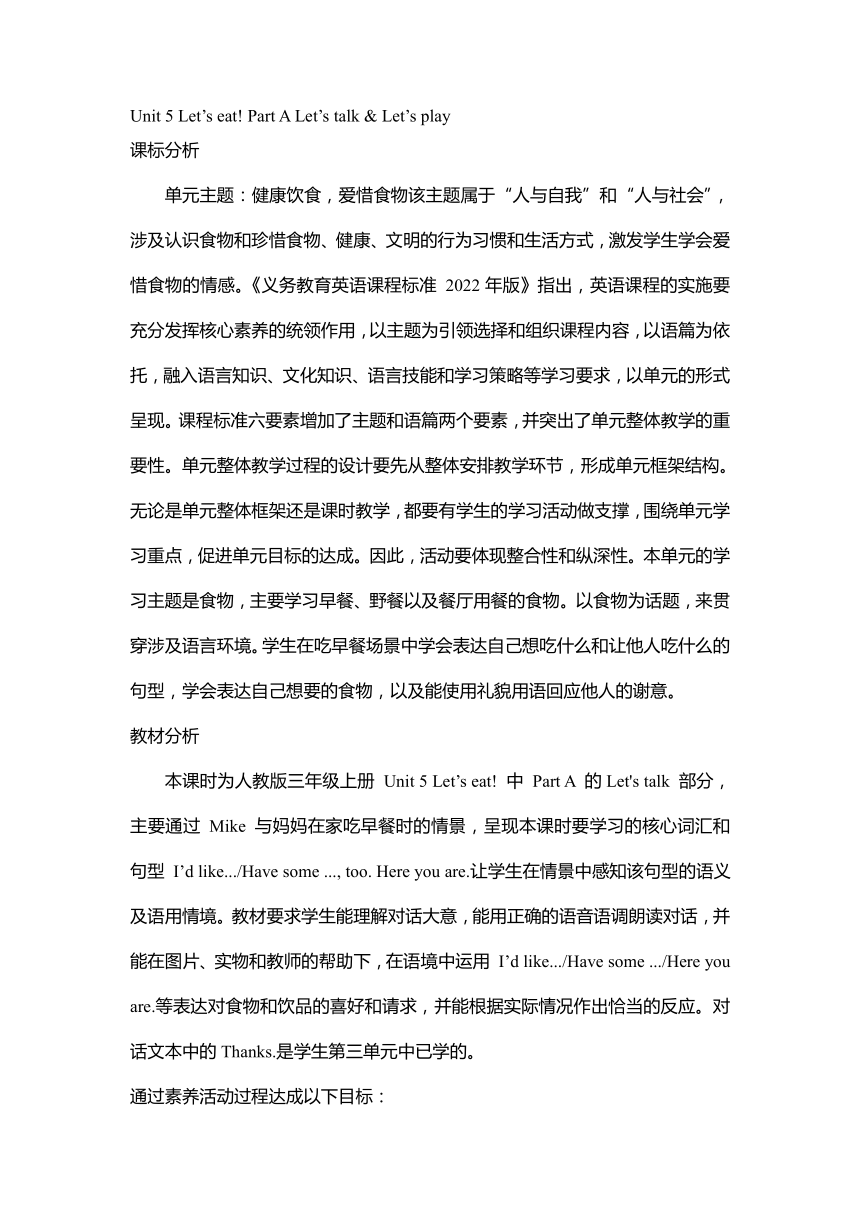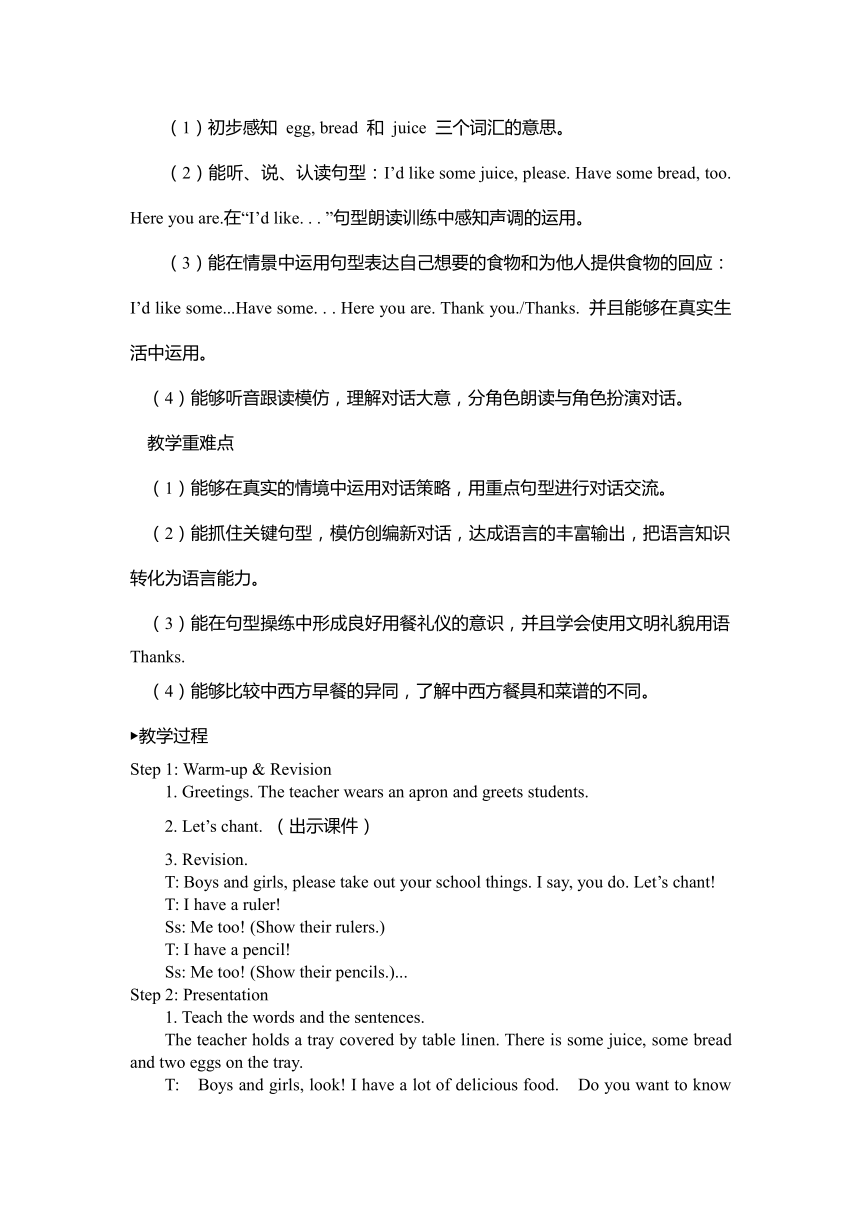Unit 5 Let’s eat! Part A Let’s talk 教案(含反思)
文档属性
| 名称 | Unit 5 Let’s eat! Part A Let’s talk 教案(含反思) |

|
|
| 格式 | docx | ||
| 文件大小 | 22.3KB | ||
| 资源类型 | 教案 | ||
| 版本资源 | 人教版(PEP) | ||
| 科目 | 英语 | ||
| 更新时间 | 2024-06-21 14:41:10 | ||
图片预览


文档简介
Unit 5 Let’s eat! Part A Let’s talk & Let’s play
课标分析
单元主题:健康饮食,爱惜食物该主题属于“人与自我”和“人与社会”,涉及认识食物和珍惜食物、健康、文明的行为习惯和生活方式,激发学生学会爱惜食物的情感。《义务教育英语课程标准 2022年版》指出,英语课程的实施要充分发挥核心素养的统领作用,以主题为引领选择和组织课程内容,以语篇为依托,融入语言知识、文化知识、语言技能和学习策略等学习要求,以单元的形式呈现。课程标准六要素增加了主题和语篇两个要素,并突出了单元整体教学的重要性。单元整体教学过程的设计要先从整体安排教学环节,形成单元框架结构。无论是单元整体框架还是课时教学,都要有学生的学习活动做支撑,围绕单元学习重点,促进单元目标的达成。因此,活动要体现整合性和纵深性。本单元的学习主题是食物,主要学习早餐、野餐以及餐厅用餐的食物。以食物为话题,来贯穿涉及语言环境。学生在吃早餐场景中学会表达自己想吃什么和让他人吃什么的句型,学会表达自己想要的食物,以及能使用礼貌用语回应他人的谢意。
教材分析
本课时为人教版三年级上册 Unit 5 Let’s eat! 中 Part A 的Let's talk 部分,主要通过 Mike 与妈妈在家吃早餐时的情景,呈现本课时要学习的核心词汇和句型 I’d like.../Have some ..., too. Here you are.让学生在情景中感知该句型的语义及语用情境。教材要求学生能理解对话大意,能用正确的语音语调朗读对话,并能在图片、实物和教师的帮助下,在语境中运用 I’d like.../Have some .../Here you are.等表达对食物和饮品的喜好和请求,并能根据实际情况作出恰当的反应。对话文本中的Thanks.是学生第三单元中已学的。
通过素养活动过程达成以下目标:
(1)初步感知 egg, bread 和 juice 三个词汇的意思。
(2)能听、说、认读句型:I’d like some juice, please. Have some bread, too. Here you are.在“I’d like. . . ”句型朗读训练中感知声调的运用。
(3)能在情景中运用句型表达自己想要的食物和为他人提供食物的回应:I’d like some...Have some. . . Here you are. Thank you./Thanks. 并且能够在真实生活中运用。
(4)能够听音跟读模仿,理解对话大意,分角色朗读与角色扮演对话。
教学重难点
(1)能够在真实的情境中运用对话策略,用重点句型进行对话交流。
(2)能抓住关键句型,模仿创编新对话,达成语言的丰富输出,把语言知识转化为语言能力。
(3)能在句型操练中形成良好用餐礼仪的意识,并且学会使用文明礼貌用语 Thanks.
(4)能够比较中西方早餐的异同,了解中西方餐具和菜谱的不同。
教学过程
Step 1: Warm-up & Revision
1. Greetings. The teacher wears an apron and greets students.
2. Let’s chant. (出示课件)
3. Revision.
T: Boys and girls, please take out your school things. I say, you do. Let’s chant!
T: I have a ruler!
Ss: Me too! (Show their rulers.)
T: I have a pencil!
Ss: Me too! (Show their pencils.)...
Step 2: Presentation
1. Teach the words and the sentences.
The teacher holds a tray covered by table linen. There is some juice, some bread and two eggs on the tray.
T: Boys and girls, look! I have a lot of delicious food. Do you want to know what’s on the tray
Ss: Yes!
T: Please guess.
Ss: ...
T: Look! I have juice. I’d like some juice. Write down the sentence “ I’d like some juice.” on the blackboard and teach it. Help students get the meaning of the sentence by body language. Lead students to reply with “ Me too! ” Give a bottle of juice to a student.
T: Here you are. Have some juice.
S1: Thank you. Write down the sentences “Here you are. Have some juice.” on the blackboard and teach them.
Teach the new words “bread ” and “egg ” in the same way. Pay attention to the word “eggs”.
2. Do a matching work.
Put up the pictures of juice, bread and an egg on the blackboard. Take out the word cards.
T: Boys and girls, look at the word cards. Can you put up the word cards under the right pictures Ask three students to the front and do the matching work. Check the answers together.
3. Let’s talk.
(1) Look and say.
Let students look at the picture of “Let’s talk ” carefully. Ask some questions to help them predict the main idea of the dialogue.
(2) Teach the sentence structures.
①Play the cartoon of “Let’s talk” for the first time.(课件出示:教材 P48 Let’s talk板块的视频)
T: What would Mike like
Ss: Juice.
T: How does he say
Ss: He says, “I’d like some juice, please.” Take out some pictures of food and make a dialogue with a student.
T: What would you like Let the student pick a picture.
S1: I’d like some...
T: (Give him/her the picture.) Here you are.
S1: Thank you. / Thanks.
Play the cartoon again. Let students listen to the recording and repeat. Remind them to pay attention to the pronunciation and the intonation. Teach the sentence structure “ Have some... ” Give out some food and say, “Have some...”
Ss: Thank you. / Thanks.
③Do a dubbing show.
Lead students to read the dialogue. Let students practice in pairs. Play the video without subtitles. Let students wear the headdresses and do a dubbing show.
Step 3: Practice
1. Whisper. Let students work in groups to pass on the three sentences “I’d like some...” “Here you are.” “Have some...” in a low voice. Give the prize to the best group.
2. Let’s play.
(1) Play the video of “Let’s play”. (课件出示:教材 P48 Let’s play板块的视频) Let students say the food they see. Then let students read after the recording.
(2) Look and say. Let students look at the three pictures.
Practice the sentence structure “I’d like some...” in groups, then show in class.
Step 4: Consolidation & Extension
⑥1. Welcome to our Gourmet Festival!
(活动说明:让一些学生拿出事先准备好的食物并在讲台前依次摆开,在教室模拟美食节场景。另外的学生以小组或个人为单位上前,挑选自己想吃的美食。) 2. Share a video. Share a video about the differences between Chinese breakfast and western breakfast. (出示课件)
Homework supermarket :
Listen and read the dialogue :
Role-play the dialogue: Make a new dialogue with the new sentence patterns:
I’d like some---;Have some---
教学反思
这是一节关于食物的单词对话整合课,由于是与学生生活相关的教学内容,课堂气氛比较活跃,学生能积极愉快的配合学习,兴趣儿比较高。这节课知识连贯性非常大,我一直在贯彻着知识的互相联系,以小组比赛与合作的方式来学习。三年级的孩子们来讲,在初始阶段为他们拓展的实在有限,所以我尽可能的利用一切能结合信息来回顾之前所学过的内容。在英语教学中,我们要尽量为学生提供展示的平台,让他们觉得英语原来就是从单词到句子,再从句子到对话的简单过程,这样学生们学起来就会更加的积极主动,学习英语也是事半功倍,但这节课也有许多值得改进的地方,单词操练的句式应从易到难,循序渐进。让学生进一步巩固运用句子,才能在最后呈现时自然的输出。总之,在今后的教学设计时,要时刻牢记前面所设计的活动,为最后的输出服务。
课标分析
单元主题:健康饮食,爱惜食物该主题属于“人与自我”和“人与社会”,涉及认识食物和珍惜食物、健康、文明的行为习惯和生活方式,激发学生学会爱惜食物的情感。《义务教育英语课程标准 2022年版》指出,英语课程的实施要充分发挥核心素养的统领作用,以主题为引领选择和组织课程内容,以语篇为依托,融入语言知识、文化知识、语言技能和学习策略等学习要求,以单元的形式呈现。课程标准六要素增加了主题和语篇两个要素,并突出了单元整体教学的重要性。单元整体教学过程的设计要先从整体安排教学环节,形成单元框架结构。无论是单元整体框架还是课时教学,都要有学生的学习活动做支撑,围绕单元学习重点,促进单元目标的达成。因此,活动要体现整合性和纵深性。本单元的学习主题是食物,主要学习早餐、野餐以及餐厅用餐的食物。以食物为话题,来贯穿涉及语言环境。学生在吃早餐场景中学会表达自己想吃什么和让他人吃什么的句型,学会表达自己想要的食物,以及能使用礼貌用语回应他人的谢意。
教材分析
本课时为人教版三年级上册 Unit 5 Let’s eat! 中 Part A 的Let's talk 部分,主要通过 Mike 与妈妈在家吃早餐时的情景,呈现本课时要学习的核心词汇和句型 I’d like.../Have some ..., too. Here you are.让学生在情景中感知该句型的语义及语用情境。教材要求学生能理解对话大意,能用正确的语音语调朗读对话,并能在图片、实物和教师的帮助下,在语境中运用 I’d like.../Have some .../Here you are.等表达对食物和饮品的喜好和请求,并能根据实际情况作出恰当的反应。对话文本中的Thanks.是学生第三单元中已学的。
通过素养活动过程达成以下目标:
(1)初步感知 egg, bread 和 juice 三个词汇的意思。
(2)能听、说、认读句型:I’d like some juice, please. Have some bread, too. Here you are.在“I’d like. . . ”句型朗读训练中感知声调的运用。
(3)能在情景中运用句型表达自己想要的食物和为他人提供食物的回应:I’d like some...Have some. . . Here you are. Thank you./Thanks. 并且能够在真实生活中运用。
(4)能够听音跟读模仿,理解对话大意,分角色朗读与角色扮演对话。
教学重难点
(1)能够在真实的情境中运用对话策略,用重点句型进行对话交流。
(2)能抓住关键句型,模仿创编新对话,达成语言的丰富输出,把语言知识转化为语言能力。
(3)能在句型操练中形成良好用餐礼仪的意识,并且学会使用文明礼貌用语 Thanks.
(4)能够比较中西方早餐的异同,了解中西方餐具和菜谱的不同。
教学过程
Step 1: Warm-up & Revision
1. Greetings. The teacher wears an apron and greets students.
2. Let’s chant. (出示课件)
3. Revision.
T: Boys and girls, please take out your school things. I say, you do. Let’s chant!
T: I have a ruler!
Ss: Me too! (Show their rulers.)
T: I have a pencil!
Ss: Me too! (Show their pencils.)...
Step 2: Presentation
1. Teach the words and the sentences.
The teacher holds a tray covered by table linen. There is some juice, some bread and two eggs on the tray.
T: Boys and girls, look! I have a lot of delicious food. Do you want to know what’s on the tray
Ss: Yes!
T: Please guess.
Ss: ...
T: Look! I have juice. I’d like some juice. Write down the sentence “ I’d like some juice.” on the blackboard and teach it. Help students get the meaning of the sentence by body language. Lead students to reply with “ Me too! ” Give a bottle of juice to a student.
T: Here you are. Have some juice.
S1: Thank you. Write down the sentences “Here you are. Have some juice.” on the blackboard and teach them.
Teach the new words “bread ” and “egg ” in the same way. Pay attention to the word “eggs”.
2. Do a matching work.
Put up the pictures of juice, bread and an egg on the blackboard. Take out the word cards.
T: Boys and girls, look at the word cards. Can you put up the word cards under the right pictures Ask three students to the front and do the matching work. Check the answers together.
3. Let’s talk.
(1) Look and say.
Let students look at the picture of “Let’s talk ” carefully. Ask some questions to help them predict the main idea of the dialogue.
(2) Teach the sentence structures.
①Play the cartoon of “Let’s talk” for the first time.(课件出示:教材 P48 Let’s talk板块的视频)
T: What would Mike like
Ss: Juice.
T: How does he say
Ss: He says, “I’d like some juice, please.” Take out some pictures of food and make a dialogue with a student.
T: What would you like Let the student pick a picture.
S1: I’d like some...
T: (Give him/her the picture.) Here you are.
S1: Thank you. / Thanks.
Play the cartoon again. Let students listen to the recording and repeat. Remind them to pay attention to the pronunciation and the intonation. Teach the sentence structure “ Have some... ” Give out some food and say, “Have some...”
Ss: Thank you. / Thanks.
③Do a dubbing show.
Lead students to read the dialogue. Let students practice in pairs. Play the video without subtitles. Let students wear the headdresses and do a dubbing show.
Step 3: Practice
1. Whisper. Let students work in groups to pass on the three sentences “I’d like some...” “Here you are.” “Have some...” in a low voice. Give the prize to the best group.
2. Let’s play.
(1) Play the video of “Let’s play”. (课件出示:教材 P48 Let’s play板块的视频) Let students say the food they see. Then let students read after the recording.
(2) Look and say. Let students look at the three pictures.
Practice the sentence structure “I’d like some...” in groups, then show in class.
Step 4: Consolidation & Extension
⑥1. Welcome to our Gourmet Festival!
(活动说明:让一些学生拿出事先准备好的食物并在讲台前依次摆开,在教室模拟美食节场景。另外的学生以小组或个人为单位上前,挑选自己想吃的美食。) 2. Share a video. Share a video about the differences between Chinese breakfast and western breakfast. (出示课件)
Homework supermarket :
Listen and read the dialogue :
Role-play the dialogue: Make a new dialogue with the new sentence patterns:
I’d like some---;Have some---
教学反思
这是一节关于食物的单词对话整合课,由于是与学生生活相关的教学内容,课堂气氛比较活跃,学生能积极愉快的配合学习,兴趣儿比较高。这节课知识连贯性非常大,我一直在贯彻着知识的互相联系,以小组比赛与合作的方式来学习。三年级的孩子们来讲,在初始阶段为他们拓展的实在有限,所以我尽可能的利用一切能结合信息来回顾之前所学过的内容。在英语教学中,我们要尽量为学生提供展示的平台,让他们觉得英语原来就是从单词到句子,再从句子到对话的简单过程,这样学生们学起来就会更加的积极主动,学习英语也是事半功倍,但这节课也有许多值得改进的地方,单词操练的句式应从易到难,循序渐进。让学生进一步巩固运用句子,才能在最后呈现时自然的输出。总之,在今后的教学设计时,要时刻牢记前面所设计的活动,为最后的输出服务。
